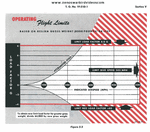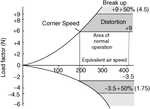drgondog
Major
We have recently experienced Troll invasion - one of which is the worst dabblers in the less than arcane arts known as "Aircraft Performance", with subchapters in throttle management, "prop disk loads changing the wingload in non-linear ways", etc.
All interesting topics and equally worth discussing - but this thread is about the huge dissemination of blivet on the subject of CORNER SPEED.
The first diagram is the Corner Speed Diagram prepared by North American Aviation to insert into the P-51D Pilots Handbook. Note carefully the message at the bottom which states that the Corner Speed calculation is for 8,000 pound Gross Weight and that the G load allowables for each condition must be factored by GWactual/64000 pounds.
Note the 'accelerated stall' area sets one boundary of the lower speed threshold.. so a 3G sustained turn at 160mph at 8000 pounds on the deck is on the threshold for departure but not structural limit and not corner speed. Note that at 6G the sustained turn at ~230mph is at stall but NOT Corner Speed. Note@ 8G at ~ 260 mph at 8000 pounds at sea level the airframe has reached CORNER SPEED.
More later - but Note for the second (conceptual) diagram that the Corner Speed at ~ 195mph is at the 6 "G" load for Design Limit and that Distortion (non elastic deformation) begins and continues until Ultimate Load Factor (9. =50%) or 13.5G is reached and complete catastrophic failure is predicted. BTW I have no idea why the left value indicators for 6G load has a +9 on the far right
I suspect they meant to either have 6G load factor with a +6 on the right and a +6+50% (3.) on upper right to be consistent.
All interesting topics and equally worth discussing - but this thread is about the huge dissemination of blivet on the subject of CORNER SPEED.
The first diagram is the Corner Speed Diagram prepared by North American Aviation to insert into the P-51D Pilots Handbook. Note carefully the message at the bottom which states that the Corner Speed calculation is for 8,000 pound Gross Weight and that the G load allowables for each condition must be factored by GWactual/64000 pounds.
Note the 'accelerated stall' area sets one boundary of the lower speed threshold.. so a 3G sustained turn at 160mph at 8000 pounds on the deck is on the threshold for departure but not structural limit and not corner speed. Note that at 6G the sustained turn at ~230mph is at stall but NOT Corner Speed. Note@ 8G at ~ 260 mph at 8000 pounds at sea level the airframe has reached CORNER SPEED.
More later - but Note for the second (conceptual) diagram that the Corner Speed at ~ 195mph is at the 6 "G" load for Design Limit and that Distortion (non elastic deformation) begins and continues until Ultimate Load Factor (9. =50%) or 13.5G is reached and complete catastrophic failure is predicted. BTW I have no idea why the left value indicators for 6G load has a +9 on the far right
I suspect they meant to either have 6G load factor with a +6 on the right and a +6+50% (3.) on upper right to be consistent.
Attachments
Last edited:


